A good streak of positive absorption activity in the Calgary office real estate market came to an end in Q4 2022, according to a market report published by Avison Young this week.
The Calgary office market saw -120,519 sq. ft of absorption in Q4, primarily in the Downtown Calgary market, which accounted for -219,840 sq. ft and was softened by the positive absorption in the Suburban market (+95,543 sq. ft) and Beltline market (+3,778 sq. ft).
"Much of the gain the market experienced this quarter was offset by major downtown tenants in the energy industry 'right-sizing' their operations," Avison Young said.
Despite the undesirable ending, however, Calgary finished 2022 with +131,820 sq. ft of absorption, with Avison Young describing the year as one of the strongest leasing environments Calgary has seen in several years.
An economic outlook published by the City of Calgary in Fall 2022 quantified what most in the Calgary office market had already been aware of for years: Calgary had accumulated too much office space too quickly in the past decade or so.
The report found that over 4M sq. ft of office space supply was added between Q1 2013 and Q4 2017, and was unfortunately followed by a sharp reduction in demand, by over 6M sq. ft. That left Calgary with an excess of office space, which the City is now hoping to convert into residential buildings.
READ: Adapt or Die: Why Converting Offices Into Homes Hasn’t Taken Off in Canada
In more-recent years, demand for office space has dropped around the world as a result of the COVID-19 pandemic and the widespread shift towards remote work. Economic factors are now adding to the list of considerations, resulting in the aforementioned "right-sizing" of companies and reconsideration of the need for office space.
"Much of the last six months had a negative cloud over it with an anticipated recession coming," Avison Young notes. "Many industry experts are predicting a slow down for the entire CRE sector in 2023 with investment levels anticipated to be in flux amidst an environment of fiscal restraint."

The overall vacancy rate is now at 23.8% -- down 2.2% compared to Q4 2021 -- as a result of a headlease rate of 19.3% and a sublease rate of 4.5%. Class AA and A space had the lowest vacancy rate, at 16.4%, while also having the highest sublease vacancy rate, at 5.7%, evidence of the much-discussed "flight to quality." The headlease vacancy rate of Class B office space is now at 27.8% -- the highest of all classes -- while Class C office space has the lowest sublease vacancy rate, now at 1.3%.
By pure supply and the number of buildings, Calgary now has 660 office buildings, with nearly half of it -- 314 -- Class AA or A, but that space accounts for nearly 70% of the total 79M sq. ft of inventory Calgary now has.
READ: 3-Storey, 14-Acre Calgary Herald Building Sold, Ahead of Postmedia Layoffs
Looking at submarkets, Downtown and the Beltline had the highest overall vacancy rate, at 27.2% and 24.4%, respectively. The Suburban Southeast (20.1%) and Suburban Northwest (20.0%) submarkets also had vacancy rates over 20%, with all other submarkets below 18%, and several below 15%.
"Submarkets outside of Downtown had a banner year, and much of that is attributed to the diversity of tenants the segment lends itself to," Avison Young says. "The healthcare, engineering, and energy sectors were the most active in 2022."
"Calgary's burgeoning tech sector is still on the rise, but the activity seen hasn't been enough to drive market forces just yet," they add. "The start-up and small-cap tech scene has traditionally been attracted to inner-city and suburban submarkets, but the downtown with its larger floorplates and rich social scene are changing this dynamic."
The Avison Young report did not include data about rental rates, but noted that they have been on an upward trajectory this past year, and will likely continue seeing upward pressure as a result of the flight to quality and inflation.





















